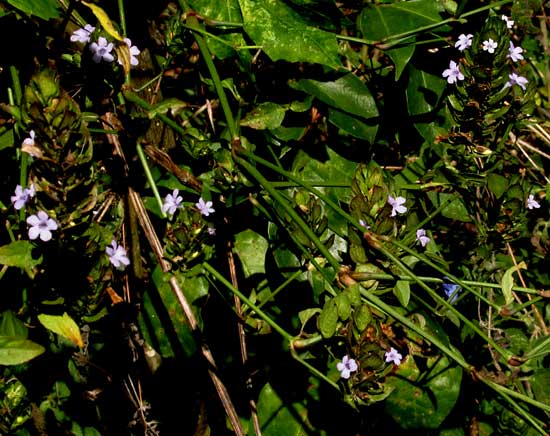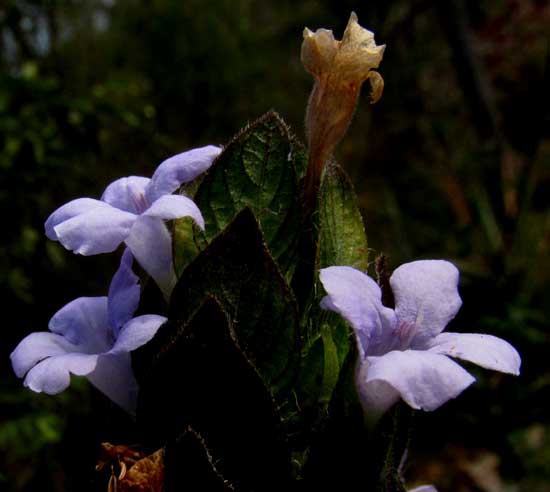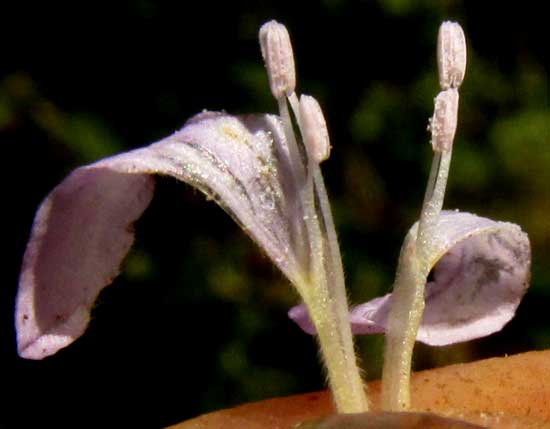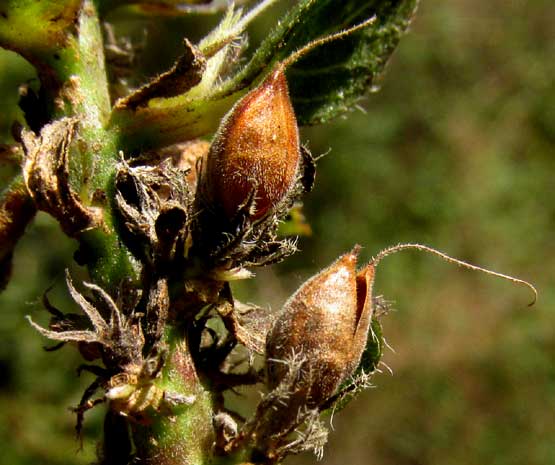Excerpts from Jim Conrad's
Naturalist Newsletter
from the March 4, 2018 Newsletter issued from Rancho Regenesis in the woods ±4kms west of Ek Balam Ruins; elevation ~40m (~130 ft), N20.876°, W88.170°; north-central Yucatán, MÉXICO
WILDFLOWER WITH AN UGLY NAME
In the head-high wall of impenetrable weeds along the garden's perimeter, just as the dry season approaches its most stressful weeks of high temperatures and droughtiness, a wildflower, which some might call a weed, has begun flowering. It's a spindly plant that uses neighbors to lean upon as its weak, diffuse branches rise to head high, but if it's growing alone it sprawls on the ground not reaching knee high. Below, you can see some flowering branches:

Other herbaceous plants are turning yellow or brown, and drying up, but somehow this plant keeps looking fresh and producing new flowers. The purplish blossoms appear to last only for a day or two, then fall off, with other blossoms in the stem-tip heads taking their places. Close up, each flower shows itself as emerging from behind a shieldlike bract, as shown below:

If you look at the flowering head, or inflorescence, from directly above, you see a striking field mark for this species, which is that the inflorescence's bracts are so regularly arranged into four rows that the entire head takes on a box-within-boxes appearance, as seen below:

We've seen this distinctive inflorescence configuration before, in the commonly occurring Hairy Fournwort, Tetramerium nervosum, of the big, mostly tropical Acanthus Family, the Acanthaceae. You might enjoy comparing our species with it, shown at www.backyardnature.net/yucatan/fournwrt.htm
The Hairy Fournwort's flowers are yellow and much less showy than our present species. Surely we have a second Tetramerium species. And it's true that three Tetramerium species are listed for the Yucatan. The problem is that none looks like our garden wildflower.
Eventually I noticed the feature that banishes our garden plant from the Hairy Fournwort's genus Tetramerium, plainly shown in the broken open blossom shown below:

The detail to notice is that this flower produces four stamens. Species in the genus Tetramerium bear only two. To plant taxonomists, that's a big difference, at least in the Acanthus Family. Seeing that to figure out what our garden plant was I'd need to "do the botany," I also photographed the herb's handsome capsule-type fruits, shown below:

Our prettily flowering garden plant is BLECHUM PYRAMIDATUM, native to and generally distributed throughout the American tropics and subtropics, as well as occurring as an invasive weed in many tropical and subtropical parts of the Old World.
In certain unquestionably authoritative literature, such the Flora of China, the name Blechum pyramidatum is considered a synonym of Ruellia blechum, Ruellia being the genus of several species of commonly occurring wild petunia. However, the folks at CICY, the "Center for Scientific Investigation of the Yucatan," as well as other notable institutions, prefer Blechum pyramidatum. Who knows which is the best name? What's for sure is that there's no decent English name for it, and the name Blechum is an ugly name for a pleasing plant.
In Mexico our blue-flowered Blechum traditionally has been used medicinally for headaches, contusions and "bad air." In Panama a tea of its boiled leaves is used for cleaning skin wounds, ranging from scratches to gangrene. Internally it's taken for stomach problems, including acid stomach and diarrhea.